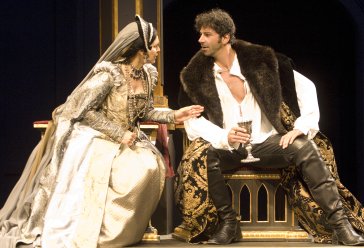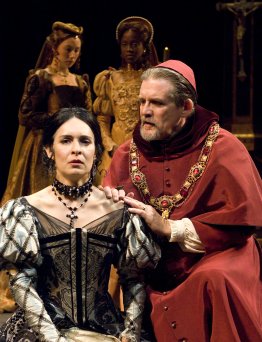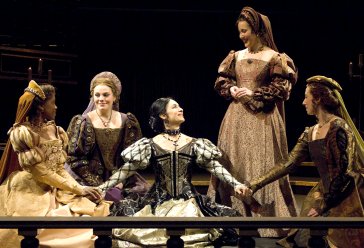Summary 
Outdoor production is elegantly staged and richly costumed, but the story is static and slow with little memorable action. Only one of three primary characters is portrayed with sufficient vitality to energize a somnambulistic text, although expert direction and elaborate staging enhance several scenes.
Design
Directed by John Sipes. Set by Michael Ganio. Costumes by Susan E. Mickey. Lights by Alexander V. Nichols. Compositions and sound by Todd Barton. Fights by John Sipes.
Cast
Elijah Alexander (King Henry VIII), Anthony Heald (Cardinal Wolsey), Vilma Silva (Queen Katherine), Christine Albright (Anne Bullen), Richard Howard (Duke of Norfolk), Michael Elich (Buckingham), Derrick Lee Weeden (Lord Chamberlain), Gregory Linington (Duke of Suffolk), Cristofer Jean (Chancellor), John Pribyl (Campeius), David Kelly (Archbishop Cranmer).
Analysis
John Sipes' handsomely mounted Henry VIII sandwiches an athletic King Henry's first appearance between two rowdy parties hosted by Cardinal Wolsey, suggesting the preeminence of the Cardinal as well as contrasting the party-mongering holy man against the physically fit ruler of the people. The outdoor production, with gold-trimmed black stairs and walls and crimson-red curtains upstage, begins with a billowing gold curtain onstage rising more than thirty feet. Five dancers wearing gaudy costumes with cardinal-red feathers lead partygoers in a wild time outside Wolsey's home. As the revelers cavort, Buckingham enters and shows disapproval, pulling down the towering golden curtains in a dramatic fury. He is arrested for treason by two soldiers, one carrying a sword and one wielding an intimidating executioner's battle-axe.


Sipes then cuts to Elijah Alexander as a swashbuckling monarch, clad in leather pants and an open white shirt that reveals his chest. With long, curly black hair and a beard, Alexander's swarthy Henry VIII battles three swordsmen at once in a furious athletic display, then poses in a wide-legged stance, a fist on his hip. He instructs a messenger to speak freely but the man turns to check with Wolsey before continuing, and the stage-right Cardinal prompts him with gestures and directions, clearly manipulating the information. During the subsequent scene, Anthony Heald's Wolsey appears in the balcony above to offer hoisted-wine-goblet toasts to his guests, and when he lurches onstage, he spills wine upon a party-goer and jokes about how he can a "shower a welcome." When masked dancers enter, he wisely exposes the disguised King Henry, always in control of the situation. Alexander's Henry, exhibiting none of the political awareness of Wolsey, becomes enamored with Anne Bullen, kissing her full on the mouth to the dismay of the other guests, as Queen Katherine observes from above, and he physically sweeps Anne off her feet as if he will whisk her away.
With the play's central conflicts firmly established by Sipes in the opening scenes, there's not much more action or poetry of significance remaining in Shakespeare's text. Sipes' design teams perform admirably, using the towering white wall of windowpanes that comprise the theatre's façade for projections - designs, colors, the lettering of correspondence - punctuating scenes with cinematic bursts of music, and filling the stage with elaborate costumes, as milling members of the court surround the central non-action in painterly portrait-like stage images. With little onstage action - events at court are broken up by asides from citizens dryly recounting political events and providing commoner reactions - the production relies on the portrayals of Henry, Wolsey, and Katherine.

Alexander's Henry cuts a dashing figure but his character postures and for the most part seems disinterested, coming across as a figurehead athlete dallying with - and perhaps not up to the mental rigors - of kingship. More interested in women and gamesmanship, Henry leaves the politics to the Cardinal, interacting with disinterest only when necessary. During Katherine's trial, he resides offstage left on a platform, only involved because the events affect him personally, and he wipes nervously at his brow with a handkerchief as the Queen challenges Wolsey. Alexander's Henry seems impressed by her pluck and spirit, soliloquizing briefly at center stage before racing halfway up the stage-right stairs then pausing a moment and coming slowly back down again, subtly indicating the King's wavering regarding his country-shaking divorce. As portrayed by Alexander, Henry VIII is no match for the political guile of the Cardinal, more a handsome icon than a flesh-and-blood monarch. As Queen Katherine, Vilma Silva speaks with a stylized and heavy Spanish accent that makes her difficult to understand. Silva's Katherine, like Henry a regal individual who strikes dramatic poses onstage, observes from below as Henry gifts Anne Bullen with a courtly title in the balcony, and she arrives for the trial amid much dramatic fanfare. Her critical scene, the public confrontation with the Cardinal, is burdened by Silva's heavy accent, and the contrived speaking weakens what little drama takes place onstage.
Apart from Buckingham's impassioned address to the public as he is led offstage to execution, Heald carries the first half of Sipes' production with his strong performance of Wolsey, just as the Cardinal dominates the English monarchy. Sometimes snide, usually pompous, and always painstakingly posed, Heald's Wolsey is imbued with a depth and presence lacking in the other two lead performances. His adversaries seem but shallow figures, one an image, the other a voice. Sipes concludes the first half of the production with one of his signature stage portraits, Henry VIII standing conflicted in a center stage spot light, with Katherine elevated above him like an angel in the balcony, and Cardinal Wolsey lurking behind him to his left, each in their own lesser spotlight.

Sipes does what he can for the dialogue-heavy but actionless second half - the song for Katherine is played upon a lute by Henry himself in the balcony, as attendants sing and dance in a circle around the Queen; and as Wolsey reads the two letters that incriminate him, he is clad in a comically scarlet night robe, and he scratches himself rudely - but there is little drama remaining. Heald's excellent closing soliloquy - "never to hope again" - stands on its own, and Sipes utilizes a deaf servant, interpreted by an attendant, advising Katherine in her final hours. Silva's Katherine, the dancers around her wearing veiled white and now appearing as though angels, receives a crown upon her head and flowers from the King himself as she begins to collapse.
Sipes concludes the production with a familiar image, as Alexander's nervous Henry fidgets at a table in the balcony - awaiting word of the birth of his child - while a serious affair of state takes place beyond his participation, Sir Thomas defying Cranmer. As the news arrives that Anne has borne a baby girl, Cranmer is saved, and before a looming white drape, Elizabeth is baptized as choral singing in bright light blacks out in a sudden hush for a cinematic if less than dramatic finish.